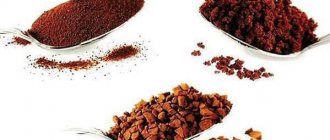- Reports and messages
- Plants
- Coffee
Coffee is the favorite drink of most adults.
When and where did he first appear? Ethiopia can safely be called the birthplace of coffee. Already in 900 AD. the inhabitants of this country discovered the wonderful properties of the plant. Gradually, coffee spread to other countries where the climate turned out to be favorable for its cultivation. Currently, the main coffee producers are Brazil, Vietnam, Colombia, Ethiopia, Cuba, India and many other countries. Coffee beans grow on coffee trees. The main varieties of coffee are Arabica and Robusta. Coffee beans are formed inside the berries that appear on the tree. When they ripen, they turn red.
Arabica beans are harvested in several stages because the berries ripen unevenly. With Robusta, everything is much simpler: the grains can hang on the tree and dry, since they do not fall to the ground. Drinks made from Arabica are more aromatic. Robusta, in turn, contains more caffeine. Both varieties complement each other perfectly.
From one tree you can collect up to 3 kg of berries. This amount yields 400 g of roasted coffee beans. Manual berry picking is preferred because the quality of the grains is much higher than with automated harvesting.
Stages of processing coffee beans: roasting, grinding and possible processing into artificial coffee.
When roasted, the beans change color from green to brown. There are four degrees of roasting. Espresso is made from the darkest roasted beans.
Ground coffee loses some of its taste and aroma, so it is worth grinding the beans immediately before preparing the drink.
Instant coffee is easy to prepare, but it loses its natural taste. Most often, coffee is prepared in a coffee maker, Turk or French press.
Coffee, like any other product, can bring both benefits and harm to the body. With moderate consumption of the drink, the human body is not in danger. Coffee helps you cheer up and has a positive effect on the brain, muscles and internal organs.
Report No. 2
Coffee is one of the indispensable and most popular drinks in modern society, which is considered the most aromatic in the world. Origin.
Initially, as legends say, coffee originated more than 1,500 thousand years ago in the 3rd century AD in Ethiopia. It is in this state that coffee still grows like a wild plant. However, it was brought into the public domain from Yemen, where it was supplied as contraband by the Arabs, from whom specific documented information was later discovered in the 10th century.
In the 17th century, there was a great demand for coffee, which is why many Europeans began to look for tropical places suitable for growing these plants. The Dutch were the first. They were able to steal some grains from the Arabs, after which they planted them in Amsterdam. A few years later, thanks to this, the famous biologist Carl Leaneus created an entire plantation that he called: “Arabica Coffee.”
And although its history is so rich, coffee began to be studied in depth relatively recently: about a couple of decades ago.
Growing.
Coffee beans are very finicky when cultivated, especially the above-mentioned Arabica variety, therefore when growing, the first thing to take into account is the temperature, which should not exceed 20-25°C and becomes below 8°C.
Soil is also an important component. Most people use loose soil with an average moisture and nutrient content.
Varieties.
The coffee tree belongs to the Madder family, which includes 60-80 varieties; only 3 are cultivated in all 80 countries: Arabica, Robusta and Liberica. There are several types of coffee on the market:
- Grain
- Ground
- Soluble
- A recently introduced milicano that combines the properties of the previous two.
Numerous drinks made from these grains are common in industry, in addition to the main one:
- Espresso
- Cappuccino
- Glasse
- Latte
- Mocha
- Mocaccino
- Americano
- Ristretto
- Romano
- Turkish coffee, which is regular strong brewed black coffee.
Effect on the human body.
Coffee has both negative and positive effects on the human body. In first place is caffeine, which dilates blood vessels, accelerating blood circulation, which is why people subsequently feel alert. However, in recent years it has been discovered that it also lowers the concentration of proteins in the brain, which helps relieve dementia. When drinking a drink, a person feels euphoria - joy, but if you drink too much, its advantages will turn into disadvantages, therefore the recommended amount is 3-4 cups per day.
Interesting Facts.
Many people who believe in paranormal events claim that the number 8, denoting infinity, is closely associated with coffee, which is why new legends are born that it is marked by higher powers.
5th grade
Abstract: Coffee and coffee drinks
Coffee
Natural coffee is obtained from the seeds of the coffee tree, which grows in all tropical countries. The coffee tree does not grow in Russia.
The fruits of the coffee tree are similar in appearance to cherries. The fruit consists of pulp, which contains one or two grains (seeds) covered with a horny membrane. The pulp of the collected fruits is separated, the grains are washed from the remaining pulp and skin, dried and the shells are removed. To give dry grains a beautiful, smooth appearance, they are polished and aged for 3 to 14 years to improve the taste. Dried and aged beans are called raw coffee beans. Raw coffee beans have no aroma, do not swell in water, do not brew well and have a strong astringent taste.
Before consumption, coffee is roasted at a temperature of 180 – 200°C. During the process of roasting, complex physical and chemical changes occur in the beans: the grains increase in volume, weight loss occurs due to water evaporation, sugars caramelize, caffeine becomes free, and a complex volatile substance “cafeol” is formed. Coffee beans acquire a characteristic taste, aroma and dark brown color.
Roasted coffee contains 7% water, 13.9% nitrogenous substances, 14.4% fat, 1.24% caffeine, 3.9% minerals, 0.056% caféol, vitamins B1, B2, PP.
Coffee stimulates the nervous system, increases the body's performance, improves metabolism, heart function, and respiratory system.
Popular message topics
- Animals of Antarctica
Antarctica is a territory with harsh climatic conditions. The temperature of the mainland is very low, and the entire territory is covered with thick ice. Despite such conditions, there is a variety of flora and fauna here, which surprises us with its - Mechanical engineering in Russia
Mechanical engineering is one of the leading areas of industry in our state. The branches of mechanical engineering in Russia are numerous and diverse, their specialization accounts for the production of a huge number of products, - Ballet
Ballet is a very subtle, beautiful and aesthetic theatrical art. Ballet originated in Italy in the mid-sixteenth century. The name ballet comes from the Italian word “ballo”, which means dance. At first the ladies danced on stage in long dresses,
The history of the spread of coffee on the planet
Coffee got its name from the southern Ethiopian province of Kafa, where wild forest thickets of Arabian coffee have survived to this day. Coffee first became of interest to shepherds who noticed the unusual liveliness of goats that tasted the fruits and leaves of the coffee tree. Or maybe one day, the shepherds dropped the fruits into the fire and, feeling the aroma of roasted coffee, said that it was good and tried to brew it.
From Ethiopia in the 12-13th century, the coffee tree came to the Arabian Peninsula to Yemen, which now supplies the best quality coffee. At first, coffee was the favorite drink of the Bedouins and caravans, and later of all the inhabitants of the Arabian Peninsula. The papal envoy Pietro della Balle in 1615, in a letter from Istanbul, said: “The Turks have a black drink that is refreshing in summer and very warming in winter... They drink it slowly after a meal, like some kind of sweet, and always in small sips to prolong the pleasure. They almost never have meetings with friends where it is not used. Why the fire is always lit, small porcelain cups are constantly ready, which are filled with this fairly hot drink!
It is known that the largest supplier of coffee is Brazil.
The history of coffee in Brazil began with a spicy and romantic intrigue. Brazil sent an ambassador to Guiana, officer Francisco Palheta. A handsome and cunning officer began an affair with the wife of the governor of Guiana. At the banquet, a lady presented him with a bouquet of flowers, and a sprout of a coffee tree was hidden in it. Brazil's humid climate and loose, fertile soil turned out to be ideal for the new crop. Brazil is now the main supplier of coffee to European countries. Currently, more than 50 countries around the world export coffee.
Goats helped us learn about coffee
Interesting facts and legends about coffee, of which there are many, indicate that this drink is very loved and consumed for a long time. It first became known in Ethiopia. The shepherd Koldi saw that the goats were eating berries, after which they became active and did not sleep even at night.
When he tried them himself, he noted that he became more alert. He shared his observation with others, and people began to eat these berries. And only after some time they began to prepare a drink from the grains. Such stories about coffee are distinguished by their originality.
Coffee and caffeine as medicines
Caffeine is used as a stimulant for mental and physical fatigue. In coffee, caffeine has become widespread as a “household” stimulant of the central nervous system. For example, caffeine affects sleep by reducing drowsiness. Caffeine increases dopamine levels in the body. Dopamine promotes a short-term feeling of euphoria.
Caffeine is also used for insufficiency of the cardiovascular system, respiratory depression, in the treatment of neuroses and headaches.
Caffeine, consumed in small quantities, stimulates the activity of skeletal muscles and the heart, increases blood pressure and body temperature and improves kidney function.
It is currently known that caffeine is included in combination tablets - askofen, caffeamine, citramon, caffeine-sodium benzoate.
Coffee was first used as a remedy in classical Arab medicine in 900 AD. Coffee appeared in Russia in 1665, when a court physician prescribed a recipe to Tsar Alexei Mikhailovich: “Boiled coffee, known by the Persians and Turks, is a fair cure for arrogance, runny noses and headaches.”
Many healers of the 15th and 16th centuries unanimously rebelled against the “terrible passion and tyrannical habit” of drinking coffee. Some even claimed that this drink shortens life, that the French minister Cobler allegedly burned his stomach by drinking coffee during night work, that some princess died from coffee, which caused a hundred abscesses in her stomach.
They say that in the 18th century, a French scientist was tasked with establishing which “poison” kills faster: coffee or tea. He received permission to conduct experiments on criminals sentenced to death - twins. One prisoner was given 3 cups of tea a day, another - 3 cups of coffee. The first lived to be 70 years old, and the second to be 80 years old. The scientist did not drink tea or coffee and died at the age of 62.
Writers recall that one doctor persuaded the French writer Bernard Fontenelle to stop drinking coffee, convincing him that coffee was a poison that acted rather slowly.
Voltaire could not work at all if there was no coffee at home. He sometimes drank 50 cups of this drink per day. Honore de Balzac drank 15,000 cups of strong coffee while writing The Human Comedy.
So let us praise coffee in the words of Küchelber:
"A direct gift from the gods themselves
Coffee is the nectar of the sages!”
In defense of coffee, Johann Sebastian Bach wrote the “Coffee Cantata” in 1732 based on poems by the German poet Picander.
Conclusion
As a result of the research, I found out that coffee beans contain caffeine, as well as various vitamins: thiamine, riboflavin, pantothenic acid, nicotinic acid, pyridoxine, tocopherol; microelements that contribute to the full functioning of the body.
Caffeine is a psychostimulant. But the effect on higher nervous activity depends on the dose of caffeine and the type of nervous system.
Caffeine has a direct stimulating effect on the respiratory and vasomotor centers of the medulla oblongata. By facilitating interneuronal transmission of excitation, it enhances spinal reflexes.
Caffeine affects various vascular areas of the body.
Under the influence of caffeine, the secretion of the gastric glands increases, and diuresis also slightly increases, which is associated with inhibition of the process of reabsorption of sodium and water ions in the renal tubules.
During my work, I found out that caffeine is contraindicated for arterial hypertension, atherosclerosis, sleep disorders and glaucoma.
So what is coffee - poison or medicine? I think coffee is a healthy drink with medicinal properties. But every medicine is good in moderation; if you exceed the dose, you can achieve negative consequences. It is known that too much caffeine (more than 750 mg) can lead to dizziness, hallucinations, and weakness. Some researchers claim that the lethal dose is about 40 cups at a time.
After doing my research, I can give some useful tips to coffee lovers:
- Do not consume coffee in large quantities. Due to health risks and the potential for physical dependence, coffee consumption should be limited to 2 cups per day.
- Do not drink coffee after 14:00. Healthy, sound sleep is very important for the normal functioning of the body. Caffeine can stay in the body for up to 6 hours or longer, which is why you should avoid consuming it in the afternoon to avoid sleep disturbances.
- Combine caffeine with fitness. It improves the effectiveness of training, and the positive effect of sports helps to increase the body's resistance to stress and gives a boost of energy for the whole day.
How was the drink distributed in Russia?
Coffee appeared in Russia thanks to Peter I. It was he who once tried this drink abroad and decided to bring it with him. The ruler liked its taste and aroma so much that he began to gather nobles and treat them to coffee.
Then public coffee shops appeared. All other residents of the country could try the drink there. Now coffee has not lost its popularity. Thanks to its availability, everyone can afford to consume it daily.
The effect of caffeine on metabolic processes in the human body
Caffeine facilitates perception, accelerates the course of associative processes, improves the function of sensory organs, increases motor activity, mental and physical performance. In the laboratory of I.P. Pavlov, excitation processes in the cerebral cortex were studied.
The fact is that the caffeine molecule is similar to the molecule of adenosine, a natural hormone found in every cell, which slows down the production of energy in the cell. Caffeine temporarily takes the place of adenosine, but it cannot inhibit energy processes and cells, especially nerve cells, become more energetic. Under the influence of caffeine, the excitability of the spinal cord, respiratory and vasomotor centers of the medulla oblongata increases.
It has also been established that caffeine inhibits the enzyme phosphodiesterase and thereby increases the level of cAMP (adenosine monophosphate) in cells, which stimulates the release of intracellular calcium ions.
— (inhibits) — Phosphodiesterase —
— increasing cAMP levels — stimulating the release of intracellular Ca 2+ ions — increasing cell excitability
The release of calcium ions is associated with the action of skeletal muscles during fatigue. Caffeine in moderation increases physical endurance and training efficiency.
The effect of caffeine on blood circulation is controversial. With normal blood pressure, caffeine does not cause significant changes in its level, because. Moreover, simultaneously with stimulation of the vasomotor center, caffeine has a direct vasodilator effect on the vessels of skeletal muscles, brain, heart and kidneys. Caffeine enhances the activity of the heart. The effects of caffeine on the body are felt within a few minutes after consumption and last for 4 to 6 hours.
Once in the body, caffeine affects hormones. Caffeine can interfere with the absorption of a hormone that calms the body, which initially sharpens attention, but can subsequently cause sleep disturbances and insomnia.
Along with caffeine, the hormone adrenaline enters the body, which provides a temporary surge of energy, which after a while is replaced by a loss of strength.
Caffeine increases levels of cortisol (the stress hormone) in the body, which promotes a range of undesirable effects, from weight gain and low mood to heart disease and diabetes.
Caffeine increases dopamine levels in the body, i.e. causes a feeling of euphoria, which quickly gives way to apathy and depression. Sudden changes in dopamine levels can lead to the formation of physical dependence.
Caffeine may reduce sleepiness and shorten hours of sleep. Consequently, there is less time left for the recovery the body needs, which affects readiness for the next day and overall health.
Many experts believe that increases in the hormone cortisol contribute to increased cravings for fats and carbohydrates, which leads to the formation of fat deposits.
Modern doctors claim that caffeine and coffee are contraindicated in cases of increased excitability, insomnia, severe hypertension, atherosclerosis, diseases of the cardiovascular system, old age, and eye disease - glaucoma.
This means that caffeine is dangerous for humans. It reduces the activity of the skin glands. Extremely large doses of caffeine have a harmful effect on the human body, causing agitation, insomnia, muscle tremors, tinnitus, cardiac arrhythmia and subsequent depressed mood.











